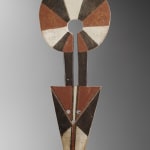 Bedu plank mask
Bedu plank mask
 Bedu plank mask
Bedu plank mask
 Bedu plank mask
Bedu plank mask
 Bedu plank mask
Bedu plank mask
 Bedu plank mask
Bedu plank mask
 Bedu plank mask
Bedu plank mask
 Bedu plank mask
Bedu plank mask
 Bedu plank mask
Bedu plank mask
 Bedu plank mask
Bedu plank mask
 Bedu plank mask
Bedu plank mask
Anonymous Nafana artist (Ivory Coast)
height 62 3/5 in
Further images
-
(View a larger image of thumbnail 1
)

-
(View a larger image of thumbnail 2
)

-
(View a larger image of thumbnail 3
)

-
(View a larger image of thumbnail 4
)

-
(View a larger image of thumbnail 5
)

-
(View a larger image of thumbnail 6
)

-
(View a larger image of thumbnail 7
)

-
(View a larger image of thumbnail 8
)

-
(View a larger image of thumbnail 9
)

-
(View a larger image of thumbnail 10
)

Vividly painted in red, white and black, this mask exemplifies the vitality and grandeur of Nafana artistry. The Nafana are a Senufo-related group, who, according to oral traditions, migrated east sometime in the seventeenth century in search of fabled gold deposits, eventually settling in a region that now borders Ivory Coast and Ghana. Their strategic location along trade routes extending between the Akan kingdom in the southern forest zone and the Saharan cultures of the northern desert led to an uninterrupted and prosperous exchange of goods, ideas, and institutions. This colorful history is reflected in the annual performance of the Bedu masquerade, for which this mask was created.
The Bedu masquerade is an artistic phenomenon of the twentieth century. It was introduced in the 1930s by Nafana artists to replace a more ancient masking cult called Sakarabounou or Sakrobundi, which had been outlawed by colonial authorities. Bedu fulfilled the same purpose without the esoteric and frightening aspects of the Sakarabounou. The positive nature of the Bedu and the ease with which it can be understood have allowed it to transcend both ethnic and religious barriers. Since its introduction, the Bedu masquerade has been adopted by multiple ethnic groups in the east central Ivory Coast and neighboring Ghana, among them the Kulango and Degha. Furthermore, while Bedu is controlled by persons of traditional African religious belief, it is accepted and even practiced by some Muslims, demonstrating that Islam and traditional Africa are not always incompatible.
Bedu masquerades perform for an annual month-long ceremony called Zaurau as well as at funerals for important elders. During this festival, which usually occurs in late November and December, Bedu masks are used to address issues of human survival, including fertility, healing, and protection of the village from both natural and social crises. Each night of the festival, the masks emerge from the forest to the dance arena in male/female pairs clad in long raffia costumes. The male masks have horns, and the female (such as this one) feature a circle or disc on top.
Bedu appearances are public, although the ritual activation of
the masks can be witnessed only by
members of the cult. The emphasis of the masquerade, however, is upon its performance before the community. It assures the living of their protection from the evils of life and encourages those who behold it to vocalize their apprehensions and fears publicly. At certain pivotal moments during the masquerade performance, tradition dictates that people vent their feelings and negative thoughts by speaking directly to the mask. The bedu itself represents a mythical ox-like beast that, in Nafana myth, cured a sick child and later disappeared into the bush. Although these masks are worn over the face, their exceptional size requires them to be made of relatively light wood. Similar masks are held in the collections of the Musée du quai Branly – Jacques Chirac in Paris (#73.1963.2.8) and Metropolitan Museum of Art in New York (#1979.206.237).
Provenance
Jean-Paul Delcourt (1925-2018), Abidjan, Ivory Coast
Antoine and Antoinise Ferrari de la Salle, Abidjan/Corsica, France, until 2013
Alexandra Martin-Blasselle-Galerie Kilangui, Cannes, France
Olivier Castellano, Paris, France, until 2016
van Rijn Collection, Brussels, Belgium
let's keep in touch
Join our community & never miss out on a DUENDE moment from now on
* denotes required fields
We will process the personal data you have supplied to communicate with you in accordance with our Privacy Policy. You can unsubscribe or change your preferences at any time by clicking the link in our emails.